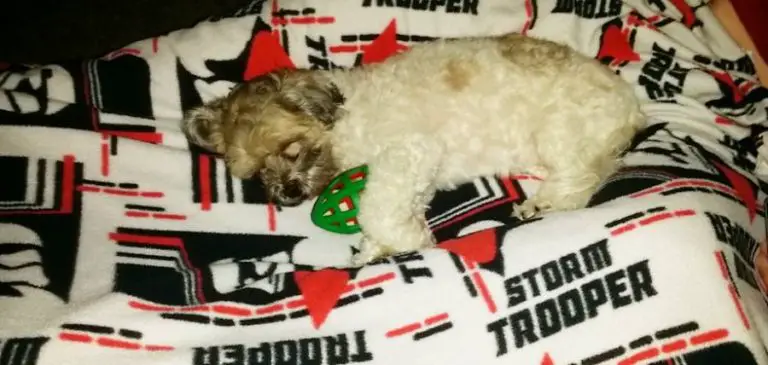The Complete Guide to Raising a Happy and Healthy Shihpoo
Your Shihpoo brings you joy, shows you unconditional love, and offers you companionship. Your responsibility involves doing what you can to keep your puppy healthy, safe, and happy. How to Keep Your Shihpoo Healthy and Happy Caring for your Shihpoo involves providing for his or her safety, health, and social well-being. Shihpoo families should help…
Your Shihpoo brings you joy, shows you unconditional love, and offers you companionship. Your responsibility involves doing what you can to keep your puppy healthy, safe, and happy.
How to Keep Your Shihpoo Healthy and Happy
Caring for your Shihpoo involves providing for his or her safety, health, and social well-being. Shihpoo families should help their puppies develop healthy eating, sleeping, and exercise habits along with offering opportunities to build strong relationships with people and other puppies.
Shihpoo families find it easy to love their furry bundles of adorableness, but it takes time and commitment to do what is right for your puppy in order to raise the healthiest and happiest Shihpoo possible. Consider each of the following categories when caring for your Shihpoo: Food, Sleep, Exercise, Love and Attention, Socializing with Other Dogs, Vaccinations, Neutering, and Protection.
Food
Buying the cheapest dog food on the shelves is like feeding yourself and your family a daily diet consisting of processed foods, empty calories, and modified meals. It may keep you and your family alive and well for a few years, but eventually, the negative health side effects will catch up to you, leading to system diseases and increased likelihood of pain and discomfort.
Dog Food
Your first choice to make when it comes to your Shihpoo’s physical health involves choosing the right dog food for his or her regular meals. Young puppies may eat three or even four meals a day while they grow, burning to more calories and having smaller stomachs. As they enter adolescence (four to six months or so) and through their adulthood, two meals a day will generally be sufficient for their energy needs.
Most families can find healthy and relatively affordable dog foods at the discount or pet stores. Other families will feel more comfortable with organic-only foods, while still other families will choose to make their own dog foods. Whichever category best describes you, be sure to keep the following in mind:
- Choose a food whose first ingredient is a protein derived from meats (beef, chicken, fish, etc.)
- Look for foods that contain fatty acids from meats (fish), seeds and vegetable oils
- If you are making your own dog food, do not assume your dog’s diet is like your own. Dogs require different levels of nutrients than humans.
- Match the foods kibble size to your Shihpoo. As a small dog, look for foods with small kibbles to make it easier for your puppy to eat.
- Find foods that have carbohydrates from whole grains and other plants.
For additional details on foods, see our post on 11 Food Tips to Raising a Healthy Shihpoo Puppy.
Training Treats
Rather than view them as dog candy and treats. consider training treats for what they are: delicious puppy snacks used to get and hold your puppy’s attention during training sessions. Training treats are usually soft and chewy snacks that puppies find irresistible.
For your Shihpoo, you may break even small training treats in half or into thirds. Use them only during training sessions and not as rewards or after-meal “desserts.” If your puppy becomes too accustomed to these treats, the treats lose their power to motivate.
Rewards and Snacks
Consider finding a couple of bags of different snacks that you can use as rewards for your puppy or just as a small treat when spending special time with your Shihpoo. You might use them as rewards for going potty outside on the lawn (early on you may even need to carry him or her out to the grass and silently encourage their duty, rewarding him or her immediately).
You might use a snack to reward your fur baby for heading into their crate for a nap. Mix up your treat giving from day to day so your puppy does not get used to getting a treat at only one or two specific times. Sometimes, unexpected rewards will create an additional bond with you and your puppy. This is something we need to work on in our home, because our two Shihpoos expect treats at certain times of the day, especially at nap time.
Regardless of when and with which treat you choose to reward your puppy, you should probably keep these snacks to a maximum of two a day. Offering treats more often will likely lead to less of an appetite for their normal food, reducing the critical nutrition they require.
Table Scraps
Like treats and snacks, table scraps should be limited in order to avoid ruining your puppy’s appetite. Remember how small your puppy is. His or her stomach is also relatively small, so if you fill it with table scraps, there will be less room and less demand for the food your puppy actually needs.
A Shihpoo’s nutritional needs are not met by human food
If you just can’t resist your puppy’s pleading eyes when you sit down for a meal, you might consider putting him or her in the crate for a few minutes until you are done eating. After all, no more than 10% of your Shihpoo’s daily nutrition should ever come from table scraps. That’s not much more than a couple of normal-sized snacks out of a store-bought bag.
Sleep

The need for both appropriate sleep quality and quantity is just as important for a Shihpoo as it is for us humans. As soon as you bring your fuzzy ball of cuteness home, establish a routine to offers undisturbed rest times during the day and a set bedtime at night.
Your Shihpoo will appreciate a regular bedtime routing just as human children do. Routines help the puppy prepare for bed. A few ideas to include in your Shihpoo’s nightly routine mind include the following:
- Brushing teeth
- Grooming while cuddling on the couch
- Heading outside for one last bladder-emptying opportunity
- Getting a dental chew in the crate
As your puppy becomes habituated to your evening bedtime routine, you will find he or she gets excited about going to bed. Because our puppies know they will receive a dental chew after they get into their crates, they love bedtime. Our olds spins and spins across the room once we bring him in from his final backyard potty run and tell him, “bed.” He can’t get into his crate fast enough. Our younger Shihpoo is a little more subdued but, by the wagging of his tail, we know enjoys bedtime (there’s a reason his nickname is Baron von Wigglebutt).
Exercise
One of the characteristics of Shihpoos that many families appreciate is their low-to-moderate need for intense or extended physical exercise. Our Shihpoos can chill all day long at home on the couch without neighborhood jogs (which they can enjoy), without spending 45 minutes in the neighborhood park chasing disks and balls (which they also love), or going on 60-minute walks through neighborhood paths and parks (which they absolutely appreciate).
Instead, many Shihpoos can get their daily activity with 15 to 30 minutes of indoor play, such as fetch and tag. If you do not take your puppy for a walk (which you should do every day for 15 to 30 minutes), make sure he or she gets out into your back yard to run around and expend any excess energy built up during their hours on the couch.
A couple of early commands you should teach your Shihpoo puppy include the “drop it” and the “leave it” commands. Once they learn to obediently drop their ball or toy at your feet or on your lap, you can easily keep them active with playing fetch for 30 to 60 minutes or more. You Shihpoo will likely play fetch as long as you are willing and able to throw something to retrieve.
Remember that Poodles have been bred as a hunter’s partner for centuries to retrieve fowl from the water. Fulfilling your Shihpoo’s inherited instincts for retrieving small objects can bring joy to your puppy for hours at a time.
Love, Affection, and Attention
The easiest part of raising a happy and healthy Shihpoo involves meeting his or her need for love, attention, and affection. You did not bring a sweet and adorable Shihpoo into your home to ignore him or her. Whether you want a couch buddy for watching movies, enjoy a furry cuddlebug to shower with hugs and kisses at the end of a long day, or a sweet sleeping companion to keep you company and serve as a personal, mobile heater at night, your Shihpoo should never lack for attention and affection.
Not all Shihpoos are as loving and affectionate at others. One first Shihpoo meets me at the door every day after work to be lifted and hugged and so he can give me a few kisses on the chin. As for cuddling on the couch, he can enjoy it for hours, so long as it is on his own terms.
Our other Shihpoo can sit for an hour in the crook of our arm like a baby, hanging out and observing anything going on around us. He is completely content to cuddle and watch. Like his brother, this puppy is happy to give love and kisses but is much happier to relax with us any time and just about anywhere.
Socializing with Other Dogs
Shihpoos not only love being around their humans and any human that comes into their home, they generally are fascinated by and enjoy playing with other dogs. This is not to say they will get along with all other dogs. There will always be a potential for conflict, so approach unfamiliar dogs with caution.
Socializing with other dogs in your home, at the other dog’s home, on the sidewalk during walks, or at the neighborhood park can provide novel experiences for your Shihpoo. Consider the opportunities described below:
Shihpoo Siblings
If you are truly committed to Shihpoos, having enough time and energy to devote to two puppies, you might consider having a second Shihpoo in your home. Commitment is the key word. Double the Shihpoo may seem double the fun and double the adorableness (which is it), but it is also double the demand.
We had our first Shihpoo for nearly two years before we brought home a sibling for him. We did not yet know there were appropriate and recommended ways to introduce a new dog to a home that already had a dog. Check out the seven steps recommended by Rescue Dogs 101 here.
Playdates
Do you have a family member, friend or neighbor with a dog you would like to introduce to your Shihpoo? Setting up frequent playdates can be good for all involved. These activities should be fun for your dog and enjoyable for you, but you should start with some basic rules:
Choosing the Activity
Consider the games and activities both your puppies enjoy. Find common ground. If one of them loves playing catch with a Frisbee but the other does not, do not try to force it on both dogs. Do they both enjoy exploring parks, neighborhood walks, jogging, or playing fetch? Choose an activity they both love, especially early on.
Choosing the Pair
Just because your family member, friend or neighbor has a dog and you have a dog does not mean the dogs are a good match for playdates. Since you have a very small dog, you should probably not pair him or her with a 50 or 70-lb Labrador, Mastiff or even a 40-lb Collie. Size matters. Even if the larger dog is as sweet as candy, dogs love roughhousing, and your Shihpoo will always come out on the bottom if things get too rough.
Find a playmate of similar size and weight. Opposite sexed dogs will usually play best together, followed by two males. If you have a girl, you may want to avoid playdates with other girl dogs, as they tend to have more issues.
Neutral Location
The first time you introduce your Shihpoo to the other puppy, do so at someone other than your home or the other puppy’s home. Have them meet at a park or even on the neighborhood sidewalks. Give them a chance to meet on neutral territory so that neither dog feels defensive on their home term.
Use Neutral Play Toys
If you want to take a toy or two with you to the park or on the walk, do not take your Shihpoo’s favorite toy or any of his or her toys for that matter. Using a toy that belongs to one of the two dogs will have the same result of trying to force a three-year old to share his favorite toy with total strangers.
Minimize the possibility of territoriality and possessiveness by bringing a new ball or a new gliding disc or a new tug-of-war rope. It does not even need to be new. It can be a cleaned, used toy from some other home, so long as it does not belong to either of the new budding friends.
Short-term Trials
After two or three times at neutral locations, if you decide to meet at a home, you might even consider holding the visitor or keeping him or her or a leash for a visit or two until the two puppies get comfortable with each other. Keep the visits short early on.
Stay Focused on the Dogs
When visiting with your own friend, stay aware of your Shihpoo and his or her new friend. Even when dogs are playing, things can get serious in a hurry when they are not quite used to each other.
Do not put the dogs outside in the back yard unsupervised. Keep an eye on them and watch for signs of whether they are getting along or headed for a confrontation.
Watch for Buddy Language
Just as a wagging tail is the sign of a happy and excited puppy, a stiff tail may give the opposite signal. When the two dogs are getting to know each other. Other signs to be on the lookout for include growling, beared teeth (snarling), a rigid posture (stiff back and tail) and even just simple staring.

Signs the puppies are enjoying their time together include lots of tail wagging from both dogs, the dogs hopping with their front paws flat on the ground and their behind raise, lots of exaggerated bouncing, taking turns rolling with their bellies up (the vulnerable position), and, of course, both dogs returning again and again for more fun.
Keep them Hydrated
Regardless of how and where your Shihpoo is playing with his or her new friend, provide plenty of water for hydration. Chances are your little fuzzy ball of adorableness will be expending a lot of energy and burning lots of calories with a new play buddy. Have a water bottle in the yard or take a bottle with you to the park.
Casual Neighborhood Walks
Taking your Shihpoo for neighborhood walks when you have the time and inclination to stop and talk to other dog walkers in the neighborhood gives your puppy the chance to meet lots of new acquaintances. When dogs meet and sniff each other, they are not only saying hello but they are learning about what the other dog eats, how the other dog is doing healthwise, and where the other dog has been, and what activities the other dog has been participating in recently. It’s kind of like checking out someone’s social media posts, just a lot more honest.
If your Shihpoo is approaching another dog for the first time, pay very careful attention to the boy language of both dogs. If the other dog is much larger than your Shihpoo, you might even consider picking your puppy up and holding him or her during the introductions.
Play Time in the Neighborhood Park
Besides playdates in the park, you can also take your puppy to the park just the two of you. Even if you don’t meet any other dogs there, let your Shihpoo do about as much sniffing as he or she wants. Your dog’s nose to the ground is gathering neighborhood news on different dogs that have visited the park, what they eat, and how they are feeling.
If there are other dogs at the park, pay attention to your puppy and other dogs as they get closer to each other. Do not allow your dog to chase or chew on toys belonging to other dogs. It’s not polite for human or canine.
Visits to the Dog Park
Dog parks can offer wonderful fun and amazing opportunities for your dog to experience something he or she will get nowhere else. This includes a variety of potential new friends, scents carried in from dozens or even hundreds of different homes in the area, and a chance to play on equipment and terrain not found anywhere else.

As with any other experience where you place Shihpoo among unfamiliar dogs, stay vigilant for body language and signs of discomfort, fear, or aggression. Do not assume that just because you are at a dog park surrounded by fences that you can let your puppy off-leash. Your Shihpoo will likely be the smallest and least aggressive dog on the grass. Do not allow any dog or human to take advantage of your puppy’s diminutive size.
Vaccinations
One of the most beneficial and important things you can do for your Shihpoo is to ensure he or she gets all of the vaccinations your veterinarian recommends. Fortunately for Shihpoos and their cousins, there is much more agreement among dog owners about the importance of immunizations than among human parents. The thought of having your puppy grow worms in his or her heart probably has a lot to do with it.
Whenever you take your puppy into the veterinarian office for shops, speak with the doctor or with the techs who do the injections about the proper dosage for your tiny puppy. Ask about the possible side effects of giving a dosage meant for a 25-lb St. Bernard to your 3-lb Shihpoo.

Recommended vaccinations help to minimize or prevent the following:
- Bordetella Bronchiseptica (bacteria causing of kennel cough)
- Canine Distemper (virus leading to problems with breathing, digestion and nerve function)
- Canine Hepatitis (a sometimes deadly viral infection of the lungs, kidneys, and liver)
- Canine Parainfluenza (a viral infection that can lead or contribute to kennel cough)
- Corona Virus (virus affecting the GI system – once infected, there is no cure, just treatments for symptoms)
- Heartworm (transmitted from mosquitos to dogs)
- Kennel Cough (a rarely deadly but highly contagious respiratory infection)
- Leptospirosis (a bacterium that may even be transmitted to people)
- Lyme Disease (tick-borne bacterium affecting heart, kidney, joints, and even neurological functions)
- Parvovirus (a deadly virus that attacks the gastrointestinal tract leading to death within just two or three days if not treated)
- Rabies (a deadly viral disease most municipalities require your puppy to be immunized against)
Generally, Shihpoos have no more complications from vaccinations than other dogs. However, when you pick your puppy up from his or her wellness visit, monitor him or her for signs of lethargy, hyperactivity, and other changes in behavior. Do not hesitate to contact the vet about concerns you might have.
Neutering
Long accepted as the right and responsible thing to do for both your dog and your community, neutering (a term technically correct for both males and females, though traditionally discussed in terms of males) has come under much greater scrutiny recently for potential health risks that temper some of the health benefits of the procedure.
One traditionally-believed advantage of neutering your dog included greater longevity. However, recent studies indicate neutering does not increase longevity and may even decrease it. Neutering may also increase the likelihood of some bone disorders and certain cancers, especially when the surgery is performed prior to the dog entering puberty.
If you plan to have your male Shihpoo castrated (we did) or your female spayed, be sure to have a very deliberate in your discussion about the timing with your veterinarian. Do not rush the procedures because you worry about growing aggression or territoriality. An extra month or two of patients may pay off big time down the road.
Protection from Elements
Part of your responsibility to care for your Shihpoo includes keeping him or her safe from the elements. The elements include excessive exposure to heat, code, rain, and snow.
Shihpoo families should not consider their puppies as outdoor dogs. Shihpoos may enjoy a few hours alone in the backyard if the temperature is mild or only slightly warm, but you should never leave your Shihpoo outside for long, unsupervised periods. This is especially true when the temperature is hot (above 90°) or cold (below 50°) or when it is snowing.
Your Shihpoo may very well love to play in the snow and can tolerate the cold for longer than you can without a sweater, but you should not leave your puppy in the snow for long periods of time. Be watchful for signs of hypothermia (shivering and lethargy being the most visible indicators).
Dressing your Shihpoo in a sweater may help, but only over the short-term. If it is snowing (or even raining), the sweater will become soaked and may actually accelerate the onset of hypothermia.
Additionally, if you decide to take your Shihpoo for a walk or jog in cold weather with snow on the ground, consider getting him or her some paw protectors. Besides keeping the paws dry and warm-ish, paw protectors can keep bits of snow-melt and de-icer granules from lodging in your puppy’s paws.
Related Questions
How long does a Shihpoo live? The life expectancy of most Shihpoos can range from 12 to as much as 20 years old, though most will live between 13 and 15 years if they have been healthy and properly cared for.
Are Shihpoos aggressive? Although some small dog breeds have reputations for being aggressive (e.g. Chihuahuas and Dachshunds), Shihpoos will rarely exhibit any aggression toward people or other dogs.









